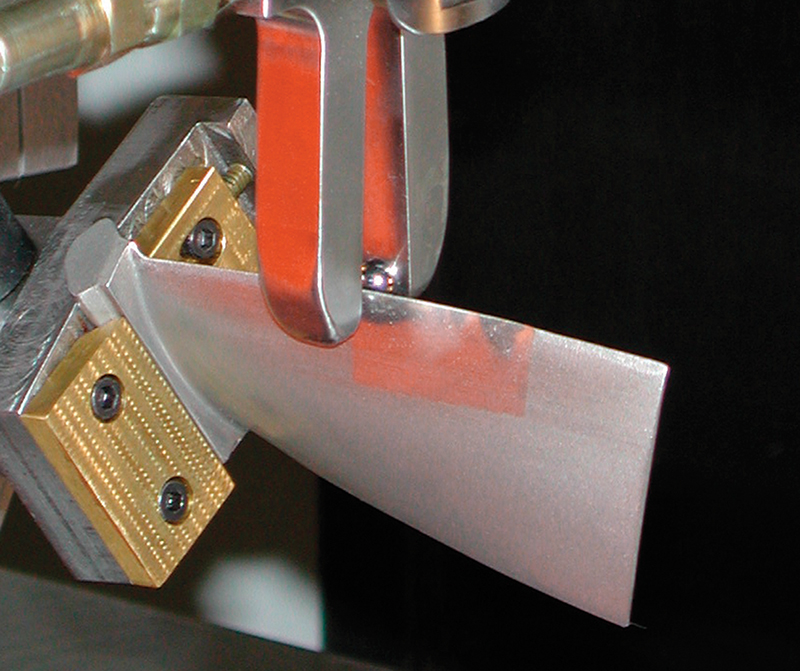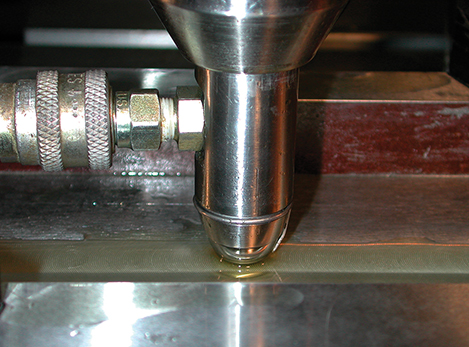
Surface Enhancement Improves Crack Resistance
Lambda Research, Inc., of Cincinnati, Ohio, has developed a low plasticity burnishing (LPB) process that will significantly increase the durability and life span of metal componentsopening the door for new advances in the aircraft industry. The company received Small Business Innovation Research (SBIR) funding and technical support from NASA's Glenn Research Center to develop the process. Glenn's partnership with Lambda supports NASA's Ultrasafe Aviation Safety program and its ongoing efforts to bring safer aircraft propulsion systems to reality. Upon successfully completing its work, Lambda created a spinoff company, Surface Enhancement Technologies (SET), also of Cincinnati, Ohio, to market the new technique, which can be applied to turbine engine metal components.
The surface finish is a critical factor in creating a durable metal component. Manufacturers strive to produce metal surfaces free of scratches, nicks, and gouges, since such defects make components vulnerable to damaging cracks. A smooth surface alone is insufficient, however, to protect the component against the wear and tear of regular usage. A component's durability is substantially improved when residual compressive stress is produced in the component's surface. In a state of perpetual compression, a surface can better withstand the stresses of fatigue and impact, increasing its life span and reducing the need for costly and time-consuming replacements.
Lambda's technique produces a deep layer of surface compression in a quick, affordable, and convenient manner. The process, designed for easy inclusion in the manufacturing environment, can be performed with conventional Computer Numerical Control machine tools. This allows parts to be processed during manufacturing, rather than as a post process in a separate facility. Unique to the process is the use of a smooth, free-rolling spherical ball suspended in a fluid, which enables single-point contact. The ball comes into mechanical contact only with the surface to be burnished, and can be moved in any direction.
The LPB process has considerable advantages over other methods of surface enhancement, such as shot peening and laser shock peening. Shot peening, the standard method, blasts tiny pellets at an area. While the method is inexpensive and widely used, the deformation from the pellet impacts can be harmful. LPB not only avoids impact damage, but also produces compressive residual stresses to a depth 4 times that of shot peening, providing much greater damage tolerance. Although its results are comparable to laser shock peening, LPB does so at a fraction of the cost. LPB's easy adaptation to manufacturing also makes it a more desirable method.LPB is applicable to all types of carbon and alloy steel, stainless steel, cast iron, aluminum, titanium, and nickel-based super alloys. In addition to improving a surface's resistance to fatigue and damage, treatment stops the growth of shallow cracks. The LPB process is currently used on the leading edges of turbine blades to improve resistance to foreign object damage and crack growth. This means significant savings for aircraft owners, since maintenance requirements to inspect for fatigue damage, replace parts, and remove corrosion damage increase the cost of operation. According to Paul Prevey, president of Lambda Research, "We fully expect it to be very useful in aircraft engine and airframe overhaul, where it can extend the life of aging aircraft and substantially reduce the overall cost of ownership." Both the military and the commercial aircraft industry stand to benefit from Lambda and SET's accomplishment.

The low plasticity burnishing process improves a surface's resistance to fatigue and damage.

A smooth, free-rolling ball comes into contact only with the surface being burnished.













